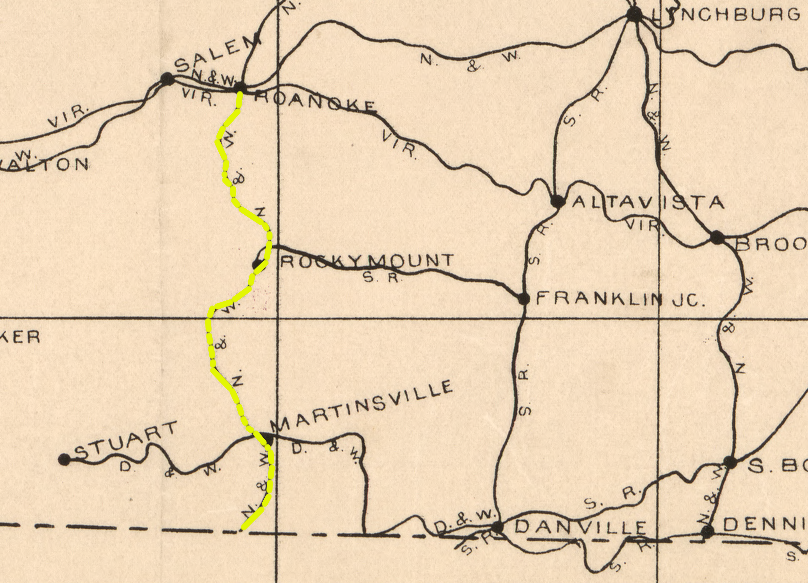
the Roanoke & Southern Railway was quickly acquired by the Norfolk and Western Railroad, becoming its Pumpkin Vine line
Source: Library of Congress, Railway mail map of Virginia (Earl P. Hopkins, 1910)

the Roanoke & Southern Railway was quickly acquired by the Norfolk and Western Railroad, becoming its Pumpkin Vine line
Source: Library of Congress, Railway mail map of Virginia (Earl P. Hopkins, 1910)
The Roanoke & Southern Railway was chartered in 1886. The 122 miles of track between Winston-Salem, North Carolina and the new city of Roanoke were completed in December, 1891.
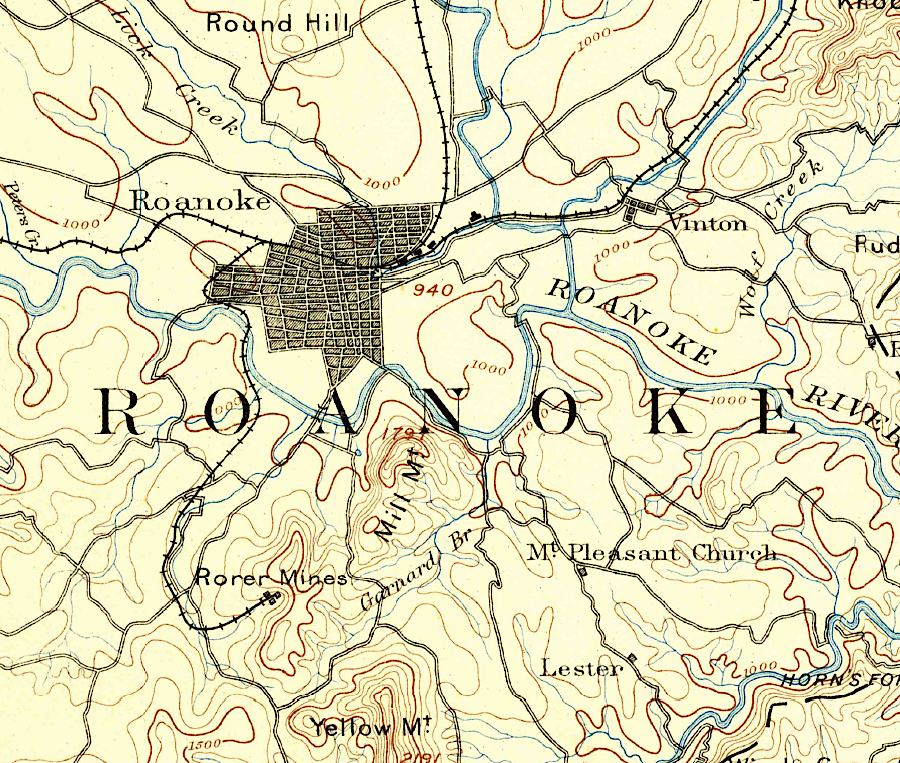
Roanoke before construction of the Roanoke and Southern Railway
Source: US Geological Survey (USGS), Roanoke, VA 1:125,000 topographic quadrangle (1891)
The Shenandoah Valley Railroad had originally contemplated building the connection. After that railroad was merged into the Norfolk and Western Railroad, it prioritized expansion westward via he New River to the coal fields at Pocahontas in Tazewell County.
Other financiers funded construction of the Roanoke & Southern Railway north from Winston-Salem to Roanoke. The city of Roanoke bought bonds, helping to ensure the destination would be Roanoke rather than Salem. The investment was expected to benefit the city because the link to North Carolina's Piedmont would increase Roanoke's business activity.
In 1890, the Roanoke & Southern Railway agreed to interchange traffic with the Valley Railroad at Roanoke. Thst would have provided an alternative route to northern customers via Baltimore, in addition to the Norfolk and Western Railroad's connections to Philadelphia via the Shenandoah Valley Railroad route. However, the Valley Railroad was never extended south of Lexington.
Francis Fries, son of the founder of the F & H Fries Mills on the New River, served as president of the construction company. The Roanoke & Southern Railway was built in one section from Winston-Salem to Martinsville, and in a second section from Martinsville through the challenging grades of the Blue Ridge Mountains to Roanoke.
When the construction project was completed, Francis Fries went into banking and founded the Wachovia Loan and Trust Company. He then opened cotton mills at Mayodan and Avalon, North Carolina, along the track of the railroad he had constructed.
The Roanoke & Southern Railway lasted as an independent company for five years, but from the beginning the investors recognized the opportunity to sell to the Norfolk and Western Railroad. In 1896, the Norfolk and Western Railway purchased it and renamed it the Norfolk, Roanoke & Southern Rail Road.
In 1911, the Norfolk and Western Railway absorbed it, ending the independent status of the Norfolk, Roanoke & Southern Rail Road and creating the Winston-Salem division of the Norfolk & Western. When the Norfolk and Western Railway and the Southern Railway merged in 1982, the line became part of the new Norfolk Southern.1
"North Carolina Railroads - Roanoke & Southern Railway," Carolana, http://www.carolana.com/NC/Transportation/railroads/nc_rrs_roanoke_southern.html; "North Carolina Railroads - Norfolk, Roanoke & Southern Railway," Carolana, http://www.carolana.com/NC/Transportation/railroads/nc_rrs_norfolk_roanoke_southern.html; "Roanoke & Southern Railway," Avalon, http://www.avalonmills.com/story3.php; John R. Hildebrand, Iron Horses in the Valley, The Valley and Shenandoah Valley Railroads, 1866-1882, Burd Street Press, 2001, p.66, https://www.google.com/books/edition/_/PDMHAAAACAAJ (last checked February 21, 2020)
Completion of the Roanoke & Southern Railway in 1891 altered plans to build a competing railroad through the mineralized Blue Ridge in Carroll and Wythe counties.
The New River Plateau Railroad had built track from Pulaski up the New River, parallel to the Roanoke & Southern Railway, to carry traffic from the iron and zinc mines in Wythe and Carroll counties. The Norfolk and Western acquired the New River Plateau Railroad and renamed it the "Cripple Creek Extension" in 1896, and bought the Roanoke & Southern Railway the same year.
Owning both lines, one already connecting Roanoke with Winston-Salem and one built halfway via Cripple Creek to that destination, gave the Norfolk and Western Railroad control of the region's freight traffic. That blocked investors from pursuing construction of a potential competitor which had been chartered in 1884. The competitor was named the Virginia and Kentucky Railroad, a name also used in 1852 for a railroad planning to build from Bristol to Cumberland Gap.2
Mary B. Kegley, "Charcoal Iron Furnaces Of Wythe County, Virginia," New River Symposium 1984, National Park Service, https://www.nps.gov/parkhistory/online_books/symposia/newriver-84/sec11.htm; Thomas Bruce, Southwest Virginia and Shenandoah Valley, Hill Publishing Company, 1891, pp.174-175, https://books.google.com/books?id=qzYtAAAAYAAJ; Randal L. Hall, Mountains on the Market: Industry, the Environment, and the South, University Press of Kentucky, 2012, pp.92-93, https://books.google.com/books?id=TRfvedYehGEC (last checked February 21, 2020)
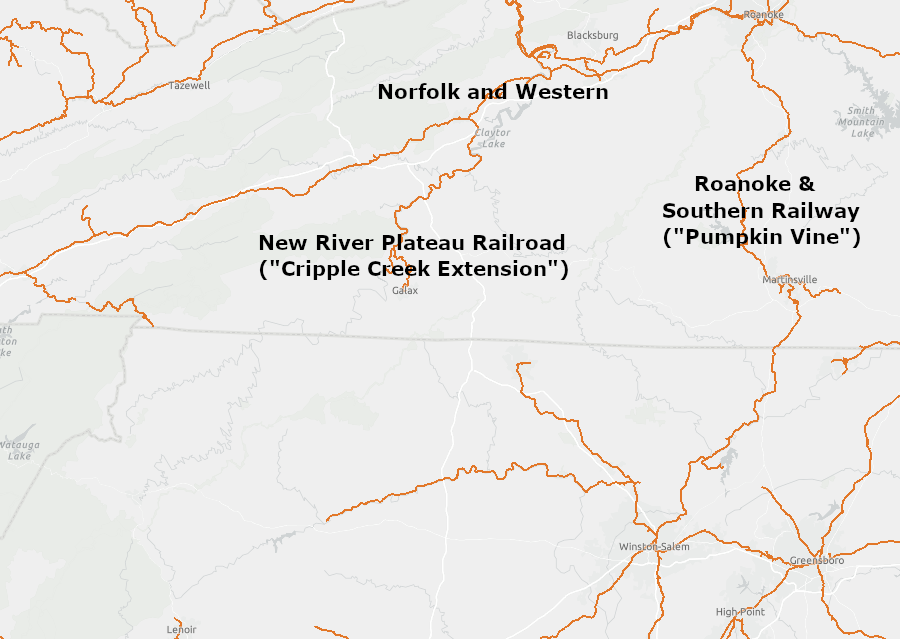
the Norfolk and Western Railway acquired control of both the New River Plateau Railroad (1889) and the Roanoke & Southern Railway (1896)
Source: ESRI, ArcGIS Online
In 1896, the Norfolk and Western absorbed the Roanoke & Southern Railway 3
Allen W. Moger, "Railroad Practices and Policies in Virginia after the Civil War," The Virginia Magazine of History and Biography, Volume 59, Number 4 (October 1951), p.437, https://www.jstor.org/stable/4245803 (last checked June 8, 2020)
The track still includes five grades that limit the speed of Norfolk Southern trains. Trains with five locomotives, hauling coal to the Belews Creek Power Plant or cars to Winston-Salem, averaged 25 miles per hour in 2011.
The line was known locally as the "Pumpkin Vine." Local lore says it was originally called the Pamlin Line, after a railroad official. A woman waiting at the Rocky Mount station, after looking at a map showing how the track snaked through the mountains, suggested that the curves resembled the stem of a growing pumpkin and the railroad should be called the Pumpkin Vine.3
"Railroad signal garners attention on Route 40 West," Franklin News-Post, June 23, 2011, https://www.thefranklinnewspost.com/news/local/railroad-signal-garners-attention-on-route-west/article_8ddd814d-1b2f-5e2f-87cf-4a3fbdc27997.html (last checked December 4, 2018)
The "Pumpkin Vine" label is not applied to just a Virginia railroad. Iowa, for example, also had a railroad with enough curves to get the name Pumpkin Vine Railroad as well.4 "All aboard! 'Pumpkin Vine' travels back to pioneer days," Daily Times Herald (Carroll, Iowa), December 8, 2011, http://carrollspaper.com/Content/Local-News-Archive/The-Spotlight/Article/All-aboard-Pumpkin-Vine-travels-back-to-pioneer-days/1/409/13119 (last checked December 4, 2018)
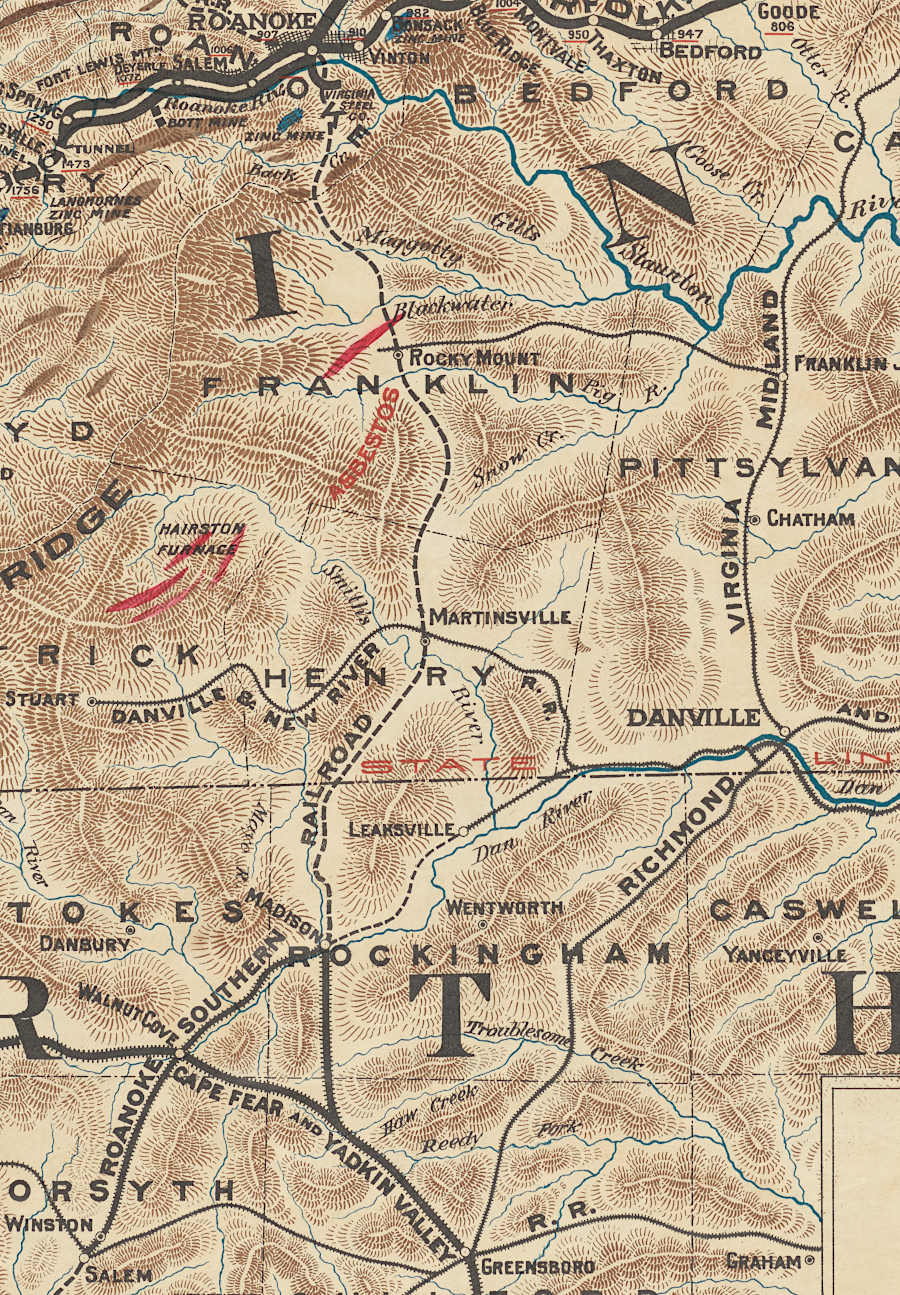
in 1890, the Roanoke and Southern Railway had not built north into Virginia yet
Source: New York Public Library, Mineral territory tributary to Norfolk and Western Railroad (1890)
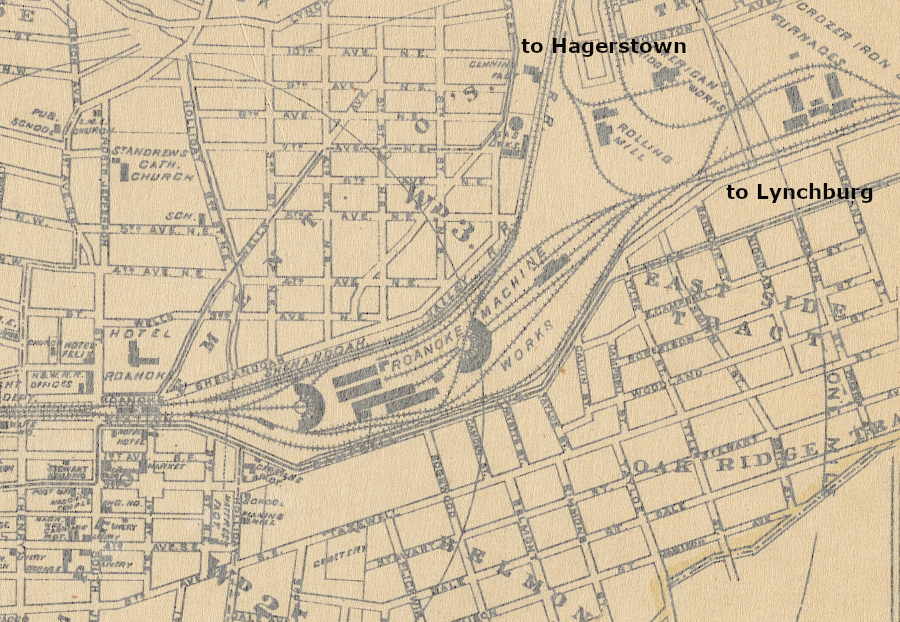
Roanoke rail layout, before contruction of the Roanoke & Southern Railway
Source: New York Public Library, Map of Roanoke, Virginia (by George William Baist, 1890)
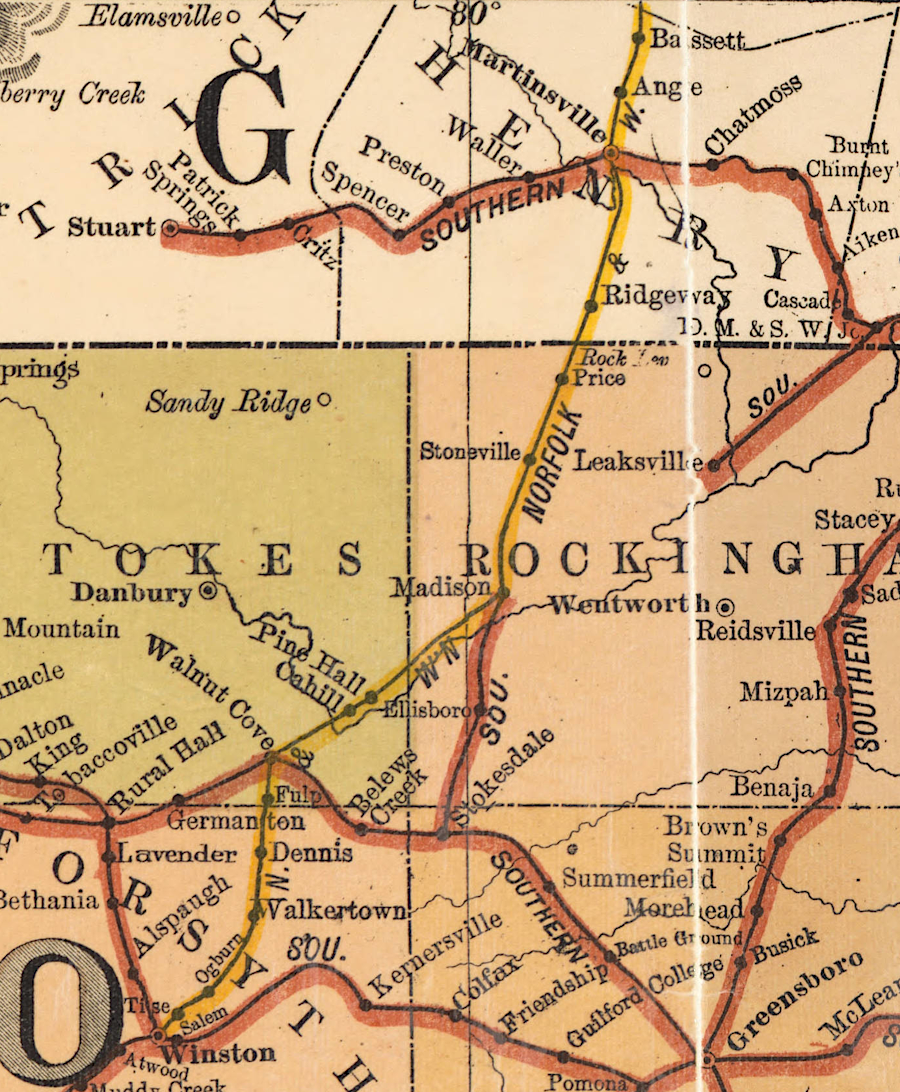
in 1900, the "Pumpkin Vine" was controlled by the Norfolk and Western Railroad
Source: Library of Congress, Railroad map of North Carolina, 1900 (by H. C. Brown, 1900)